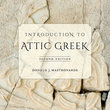 Accentuation Tutorial
Accentuation Tutorial

|
TOPICS Accent and Accent-Marking in Ancient Greek The Last 3 Syllables and the Accents Persistent Accentuation |
The accentuation of the inflected words in the vocabulary of ancient Greek is usually predictable once one knows the accentuation of the “main form” of the word. In the declension of nouns and adjectives, the accentuation is normally persistent. In the conjugation of finite verbs the accentuation is normally recessive. Persistent accentuation is seen in the declension of nouns and adjectives, where the same syllable tends to be accented in all forms, except when the length of U changes and forces the contonation to move. A move of the contonation may involve either the change of a circumflex on P to an acute (so that the contonation includes the following syllable as well) or the displacement of an acute from A to P (so that the contonation covers P + U rather than A + P). Example: in the declension of an omicron-declension noun that has the acute on a short P, the accent persists in the same form and same position in all the cases, singular and plural:
|
||||||||||||||